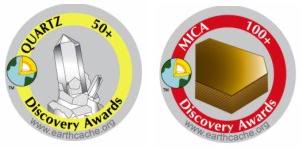Quartz:
Quartz is composed of the two most prevalent elements on Earth, silicon and oxygen (SiO2). It is the second most abundant mineral in the Earth's continental crust after feldspar. It is a constituent in metamorphic, sedimentary and igneous rocks but is actually formed during the crystallization of igneous rocks. It is very common in sedimentary type rocks such as shale and sandstone. It varies in size from giant crystals to small grains and is the main component of most types of sand. Though quartz, in its large crystal form (rock quartz), is generally colorless and transparent or translucent, it is also found in various other colors. The most familiar being pink (rose quartz), brown (smoky quartz) and purple (amethyst). Gemstone varieties of quartz, or mixed rocks including quartz, include agate, onyx, sard, carnelian, heliotrope and jasper. Because of its hardness, a 7 on the Mohs hardness scale, it is often used in the making of sandpaper, grindstones, polishers, and industrial cleaners.
Sandstone:
Sandstone, also known as arenite, is a clastic rock composed mainly of sand sized minerals and rock grains of quartz and/or feldspar. It is one of the most common sedimentary type rocks found at sites around the world. As with sand.....sandstone can be found in a variety of colors with the most common being tan, brown, red, yellow and white. As sandstone beds often form highly visible cliffs and other topographic features, certain colors of sandstone have become identified with certain areas, such as the red sandstone of Sedona Arizona and the white sandstone of the Escalante Utah area. Sandstone rock formations are porous enough to allow percolation of fluids and can be large reservoirs for water, oil or natural gas. When tectonic compression (orogeny) creates enough heat and pressure, quartz bearing sandstone morphs into quartzite.
Quartzite:
Quartzite is a hard, metamorphic rock, formed from what was once quartz sandstone. It is non-foliated, meaning it does not have layers or bands. Non-foliated metamorphic rocks are formed where temperatures are high but pressures relatively low and equally distributed. Other examples of this type of rock are metabasalt and marble. Sandstone is converted into quartzite through heating and pressure usually related to tectonic (plate) compression. Pure quartzite is generally white to light grey, but can occur in various shades of pink, yellow, green, orange and red. These color variations depend upon the amounts of iron oxide (Fe2O3) or other mineral impurities contained within. Quartzite is very resistant to chemical weathering, often forming ridges or erosion resistant hilltops. The nearly pure silica (sand) content of quartzite provides little for soil so quartzite ridges are often bare or covered by a very thin layer of soil, providing little for vegetation.
Basalt:
Basalt is a common igneous rock formed from magma hardening above ground (lava). Rocks formed in this manner are considered extrusive. Any rock formed below ground from magma, is considered intrusive. Granite is an intrusive type rock. Basalt is also aphanitic. Aphanitic describes rocks that are very fine-grained with the component mineral crystals not visible with the naked eye. When chrystals "are" large enough to be seen with the naked eye they are then considered phaneritic. Granite is phaneritic. Basalt is generally grey to black in color, but rapidly weathers to brown or red due to oxidation of its iron-rich minerals into rust. Basalt with a vesicular texture (pitted with many cavities) is called scoria. Basalt, by rule, contains less than 20% quartz by volume.
Granite:
The word "granite" comes from the Latin word granum, meaning "a grain". This is in reference to the coarse-grained structure of this crystalline rock. Granite is a common type of felsic, igneous rock. Felsic refers to rock types that are relatively rich in the elements that form feldspar and quartz. Mafic refers to rocks that are relatively rich in magnesium and iron (ferric), such as basalt. By definition, granite contains more than 20% quartz by volume. Occasionally individual crystals (phenocrysts) within the rock are larger than the rest of the crystals in the bulk of the rock. When this occurs the texture is known as porphyritic. A granitic rock with a porphyritic texture is known as a porphyry. Granite can be from pink to gray in color depending upon its chemistry and mineralogy. Outcrops of granite tend to form tors and rounded massifs and are usually found in the continental plates of the Earth's crust.
At the coordinates given you will find 3 or 4 of the rock types listed above.
1. Which of the 5 listed rock types above are Not found at the coordinates? Take a guess. Since people keep moving/stealing the signage for each individual rock type this becomes a lot harder.
2. As of June 2019, earthcaches are now allowed to have a required photo logging task. Please provide a photo of yourself, your GPSr, or a personal item, with these individual rocks and mining equipment in the background. Please post this in your log.

Permission Granted by
Brian Witty
Parks & Recreation Director
7501 E Civic Cir
Prescott Valley
(928) 759-3090